【新课标】Unit 7 Poems 第3课时Grammar课件
文档属性
| 名称 | 【新课标】Unit 7 Poems 第3课时Grammar课件 | 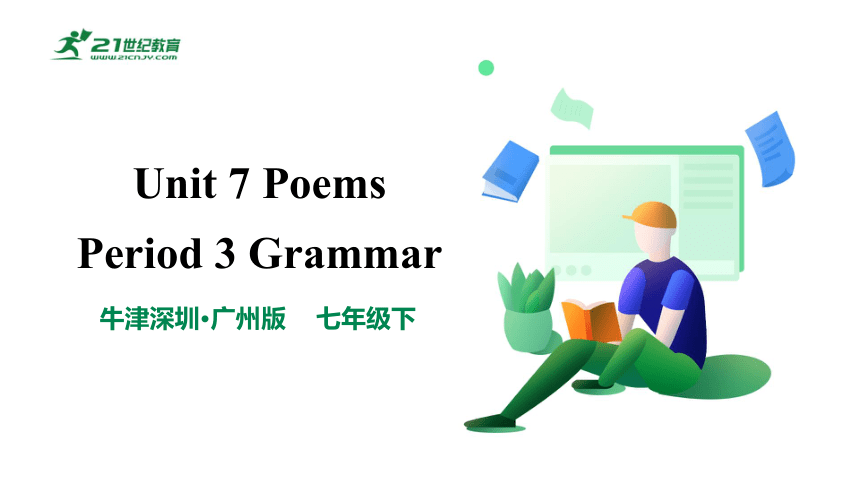 | |
| 格式 | pptx | ||
| 文件大小 | 23.9MB | ||
| 资源类型 | 试卷 | ||
| 版本资源 | 牛津深圳版 | ||
| 科目 | 英语 | ||
| 更新时间 | 2023-05-05 15:21:24 | ||
图片预览

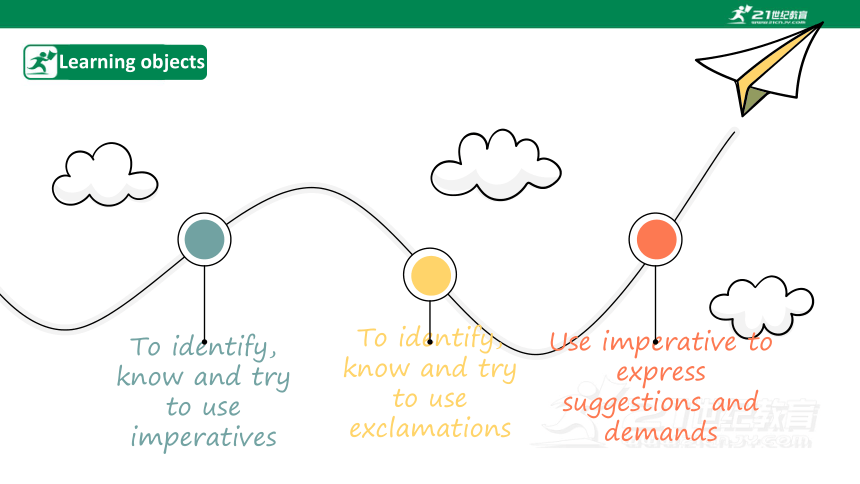
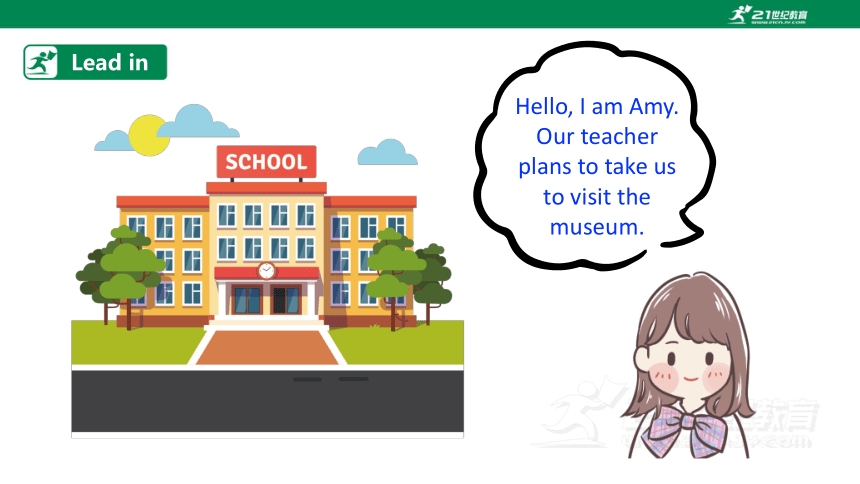
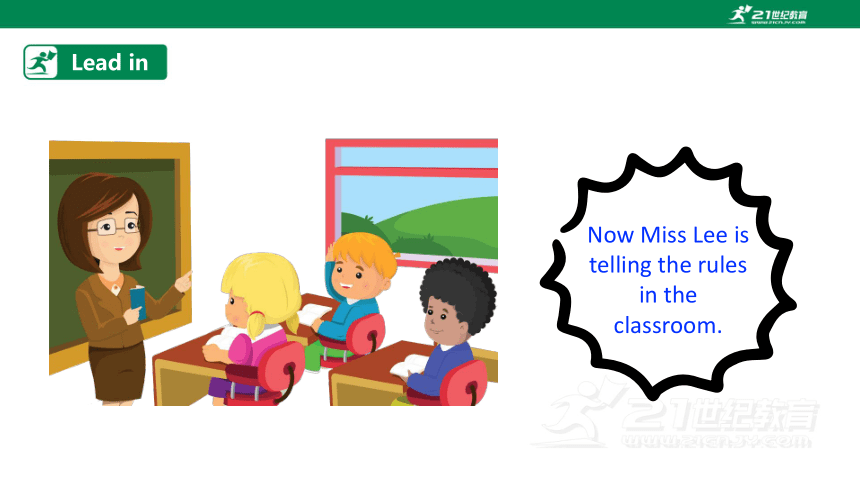
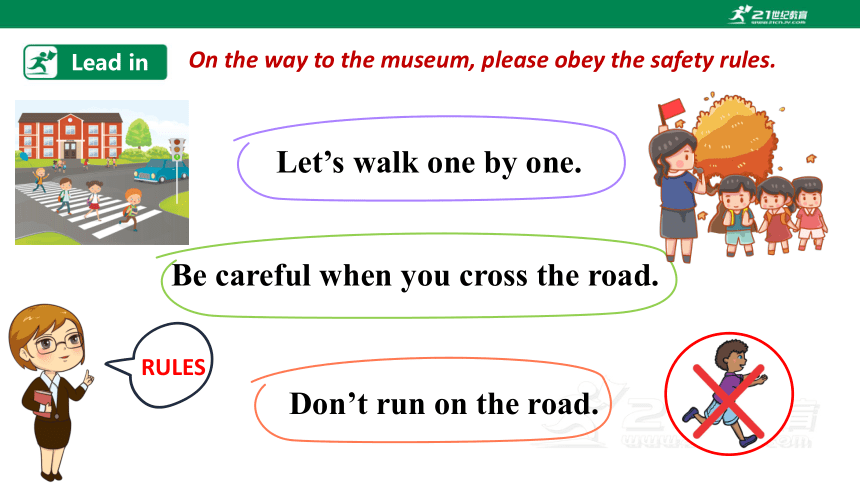
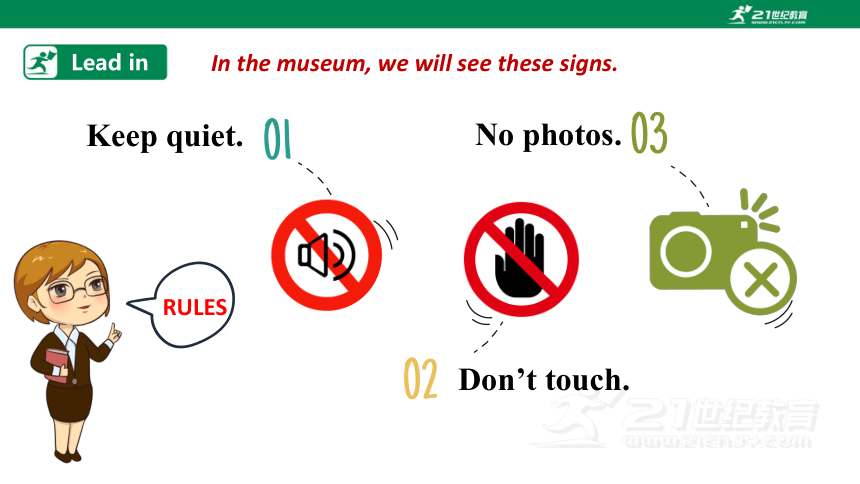
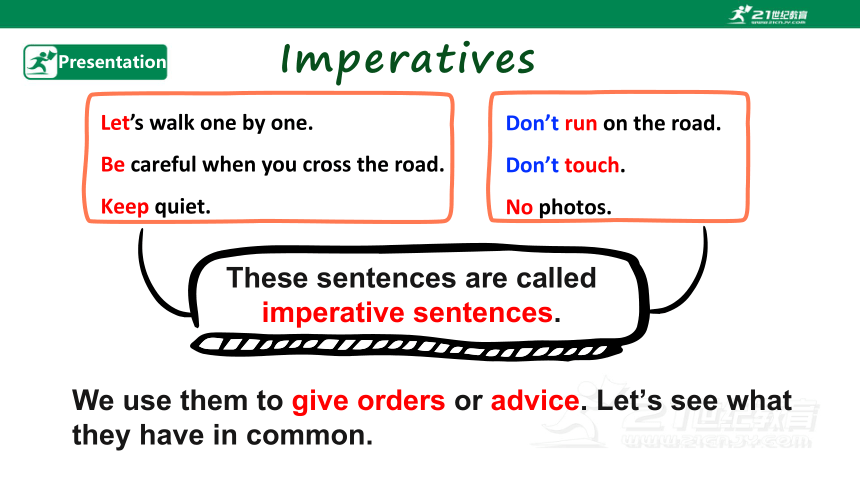
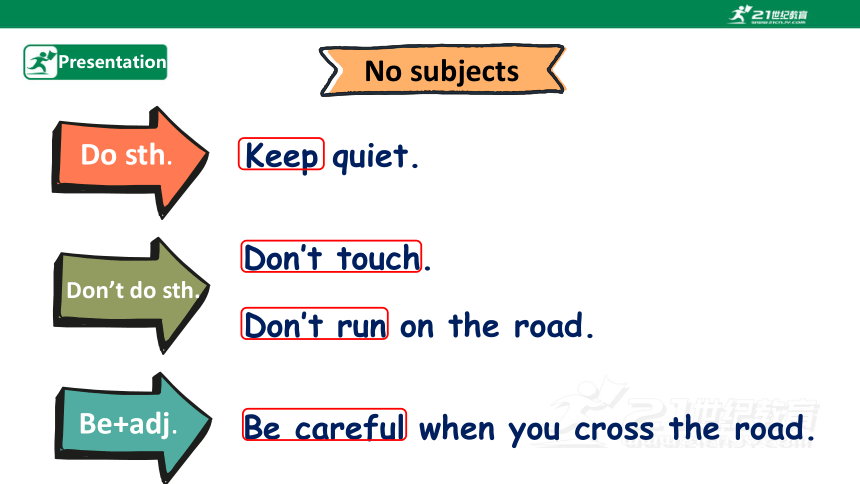
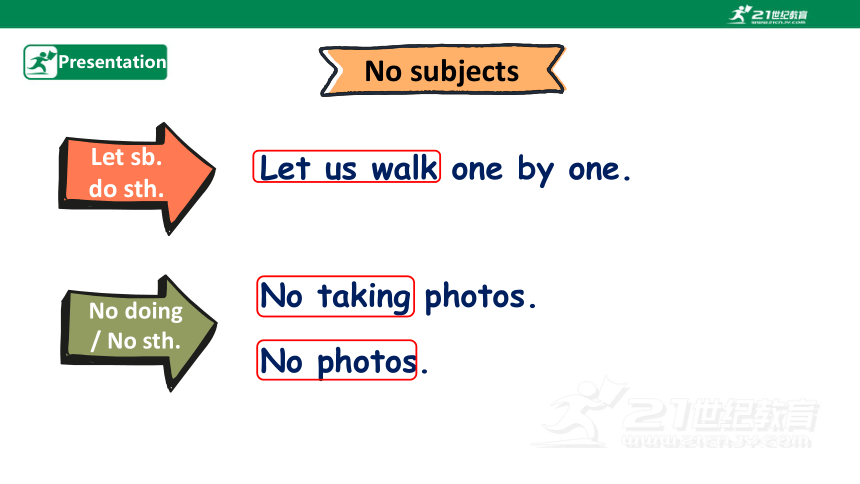
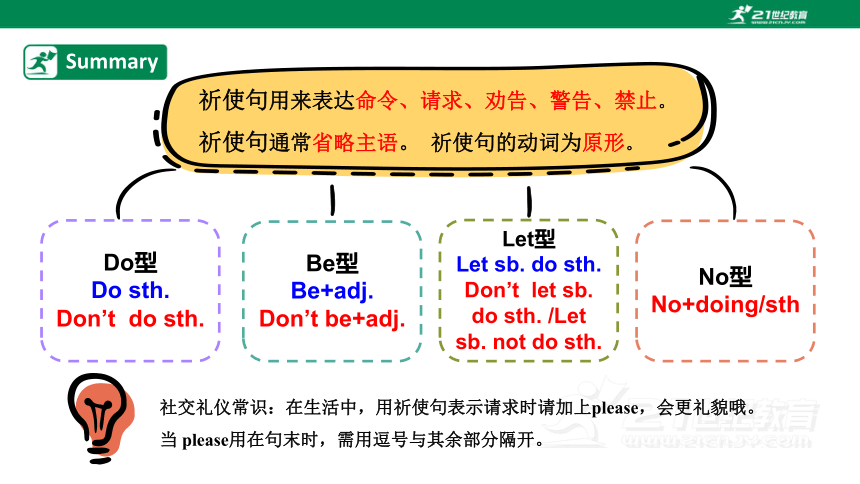
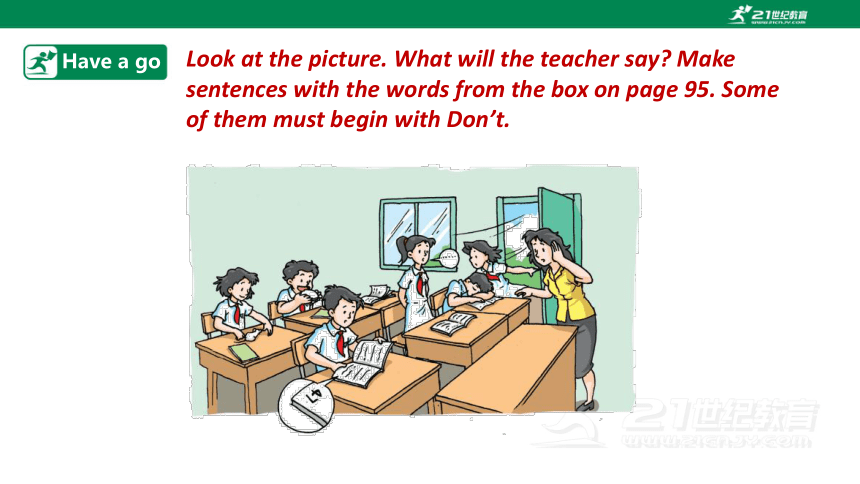
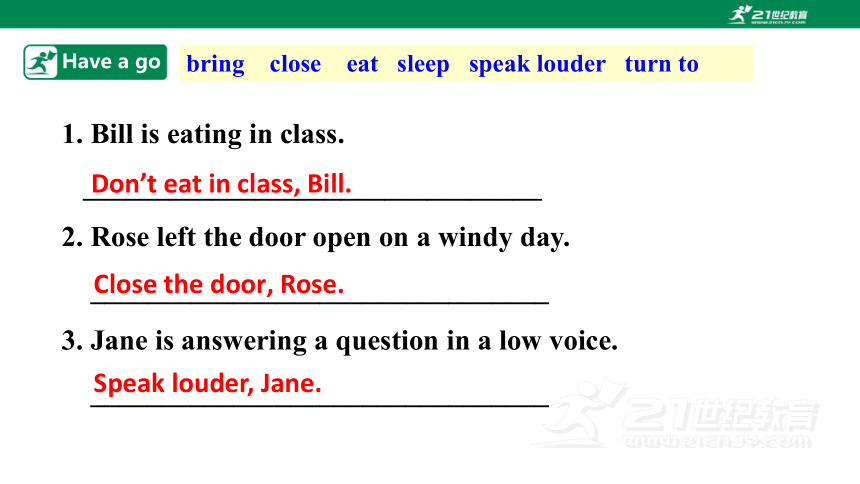
文档简介
(共42张PPT)
Unit 7 Poems
Period 3 Grammar
牛津深圳·广州版 七年级下
To identify, know and try to use imperatives
Use imperative to express suggestions and demands
To identify, know and try to use exclamations
Learning objects
Hello, I am Amy. Our teacher plans to take us to visit the museum.
Lead in
Lead in
Now Miss Lee is telling the rules in the classroom.
On the way to the museum, please obey the safety rules.
RULES
Don’t run on the road.
Be careful when you cross the road.
Let’s walk one by one.
Lead in
Keep quiet.
No photos.
Don’t touch.
In the museum, we will see these signs.
RULES
Lead in
We use them to give orders or advice. Let’s see what they have in common.
Let’s walk one by one.
Be careful when you cross the road.
Keep quiet.
Don’t run on the road.
Don’t touch.
No photos.
These sentences are called imperative sentences.
Presentation
Imperatives
Keep quiet.
Don’t touch.
Don’t run on the road.
Do sth.
Presentation
No subjects
Don’t do sth.
Be careful when you cross the road.
Be+adj.
No taking photos.
No photos.
Presentation
Let us walk one by one.
No subjects
Let sb. do sth.
No doing
/ No sth.
社交礼仪常识:在生活中,用祈使句表示请求时请加上please,会更礼貌哦。
当 please用在句末时,需用逗号与其余部分隔开。
祈使句用来表达命令、请求、劝告、警告、禁止。
祈使句通常省略主语。 祈使句的动词为原形。
Do型
Do sth.
Don’t do sth.
Be型
Be+adj.
Don’t be+adj.
Let型
Let sb. do sth.
Don’t let sb. do sth. /Let sb. not do sth.
No型
No+doing/sth
Summary
Look at the picture. What will the teacher say Make sentences with the words from the box on page 95. Some of them must begin with Don’t.
Have a go
1. Bill is eating in class.
________________________________
2. Rose left the door open on a windy day.
________________________________
3. Jane is answering a question in a low voice.
________________________________
Don’t eat in class, Bill.
Close the door, Rose.
Speak louder, Jane.
bring close eat sleep speak louder turn to
Have a go
4. James is sleeping at his desk.
__________________________________
5. Steven is looking at page 47. He should look at page 74.
___________________________________
6. Mary brought her pet mouse to school.
___________________________________
Don’t sleep in class, James.
Turn to page 74, Steven.
Don’t bring pets to school, Mary.
bring close eat sleep speak louder turn to
Have a go
1. 请坐下。
2. 请安静。
3. 别傻了。
4. 别忘了给这些花浇水。
5. 让我们坐火车去那里吧。
6. 不要打开电脑。
7. 永远都不要放弃!
Sit down, please. / Please sit down.
Be quiet, please. / Please be quiet.
Don’t be silly.
Don’t forget to water the flowers.
Let’s go there by train.
Don’t turn on the computer.
Never give up!
Exercise
将下列句子翻译成英文。
When we arrived at the museum, we enjoyed a lot of wonderful things there.
Lead in
Lead in
What a big dinosaur it is!
How beautiful the crown is!
Wonderful things in the museum
Lead in
How excellent the pictures!
What interesting things they are!
Wonderful things in the museum
Lead in
What a wonderful trip it is!
What great fun we have!
What a big dinosaur (it is)!
What interesting things (they are)!
What great fun (we have)!
加冠词a
无冠词
What 感叹句
What+(a/an)+形容词
+名词+(主语+谓语)!
单数可数名词
复数名词
不可数名词
无冠词
Exclamations
Presentation
How beautiful (the crown is)!
How hard you work!
How感叹句
How+形容词/副词+(主语+谓语)!
形容词,做谓语am的表语。
副词,修饰谓语work。
Presentation
How do we change statements into exclamations
I am sad.
主语(S) + 谓语(V) + 形容词(adj.)
How sad I am !
How + 形容词(adj.) + 主语(S) + 谓语(V) !
用How
Presentation
You work hard.
主语(S) + 谓语(V) + 副词(adv.)
How hard you work !
How + 副词(adv.) + 主语(S) + 谓语(V) !
用How
Presentation
It is a great decision.
主语(S) + 谓语(V) + (a/an) + 形容词(adj.) + 名词(n.)
What + (a/an) + 形容词 + 名词 + (主语+谓语)!
What a great decision it is!
用What
Presentation
What + 形容词 + 名词 + (主语 + 谓语)!
What helpful rules they are!
用What
They are helpful rules.
主语(S) +谓语(V)+ 形容词(adj.)+ 名词(n.)
Presentation
It is fine weather today.
主语(S) +谓语(V)+ 形容词(adj.)+ 名词(n.)
What + 形容词 + 名词 + (主语 + 谓语)!
What fine weather it is today!
用What
Presentation
感叹句
1.感叹句是用来表达赞美、惊叹、喜悦等强烈情感的句子。通常由what或how引导,句末多用感叹号。
Summary
2. 感叹句的用法和句式
引导词 用法 句式
what 对句子中的名词表示感叹 1. What + a / an +形容词+可数名词单数(+主语+谓语)!
2. What +形容词+不可数名词/可数名词复数(+主语+谓语)!
how 对句子中的形容词或副词表示感叹 1. How +形容词/副词(+主语+谓语)!
2. How +主语+谓语!
Summary
Summary
How cold it is today! 今天真冷啊!
How wonderfully they are dancing! 她们跳舞跳得真好!
How time flies! 光阴似箭啊!
What an interesting story (it is)! 真是个有趣的故事啊!
What fresh air it is in this town! 小镇的空气真清新!
What interesting books you are reading! 你正在读的书真有趣!
WHAT
HOW
3. what与how引导的感叹句,一般情况下可以相互转换,转换后意义不变。
What an interesting story it is!
= How interesting the story is!
How beautiful the building is!
= What a beautiful building it is!
Summary
4. 在英语口语中,由what 引导的感叹句中的主语、谓语,甚至形容词有时可省略。
What fresh air!
What a match!
同样地,由how 引导的感叹句有时也可省略主语和谓语。
How cold!
How wonderfully!
Summary
5. 英语中还可以用其他方式表示感叹。
运用语气词:
Ah! Wow!
运用单词或短语:
Great! Good! Very interesting!
运用简短的句子:
He works fast!
Summary
B1 Rewrite the sentences below using exclamations with what or how.
1. You are wearing an old shirt.
_______________________________________
2. The boys are very excited.
_______________________________________
3. They are friendly people.
_______________________________________
4. She studies very hard.
_______________________________________
What an old shirt you are wearing!
How excited the boys are!
What friendly people they are!
How hard she studies!
Have a go
B2 Lisa and Bob are talking about their plete their conversation with the exclamations from the box.
Oh no! How wonderful! What a lovely baby!
Have a go
Lisa: Tom won the first prize in the speech competition.
Bob: _______________ He must be very happy.
Lisa: Yes. But Jeff hurt his leg when he played basketball.
Bob: ______________ How is he feeling now
Lisa: He’s feeling better. By the way, our Maths teacher had a baby last month. Look, here’s a picture.
Bob: Wow! _____________________
How wonderful!
Oh no!
What a lovely baby!
1. _____ tall the man is! _____ well he plays basketball!
2. _____ beautiful flowers they are!
3. _____ wonderful news it is! All of us are very happy.
4. _____ fast the students run!
5. _______ nice day it is today! Let’s go out to play.
How
How
What
What
How
What a
Exercise
一、将下列感叹句补写完整。
6. _____ clever the girl is!
7. --- ________ interesting film they introduced to us!
--- Oh, yes! _______ film!
8. --- ________ snowy day!
--- Yes! _____ cold!
How
What an
What a
What a
How
Exercise
( )1. --- Please ____ to return my book by Friday. I’ll use it on Saturday.
--- No problem. I’ll finish reading it on Thursday.
A. don’t forget B. not to forget
C. not forget D. forget not to
( )2. --- ____ clever the girl is!
--- So she is.
A. How B. What C. How a D. What a
A
A
Exercise
单项选择。
( )3. ____ wonderful news it is! All of us are very happy.
A. What a B. What C. How a D. How
( )4. --- ____nice day it is today! Let’s go out to play, shall we
--- That’s a good idea.
A. How B. What C. How a D. What a
B
Exercise
D
( )5. ____ beautiful flowers they are!
A. How B. What C. How a D. What a
( )6. ____ tall the girl is!
A. How B. How a C. What D. What a
A
B
Exercise
Homework
Finish Grammar exercise paper.
By riverside a pair of turtledoves are cooing.
关关雎鸠,在河之洲。
Reflection
谢谢
21世纪教育网(www.21cnjy.com)
中小学教育资源网站
兼职招聘:
https://www.21cnjy.com/recruitment/home/admin
Unit 7 Poems
Period 3 Grammar
牛津深圳·广州版 七年级下
To identify, know and try to use imperatives
Use imperative to express suggestions and demands
To identify, know and try to use exclamations
Learning objects
Hello, I am Amy. Our teacher plans to take us to visit the museum.
Lead in
Lead in
Now Miss Lee is telling the rules in the classroom.
On the way to the museum, please obey the safety rules.
RULES
Don’t run on the road.
Be careful when you cross the road.
Let’s walk one by one.
Lead in
Keep quiet.
No photos.
Don’t touch.
In the museum, we will see these signs.
RULES
Lead in
We use them to give orders or advice. Let’s see what they have in common.
Let’s walk one by one.
Be careful when you cross the road.
Keep quiet.
Don’t run on the road.
Don’t touch.
No photos.
These sentences are called imperative sentences.
Presentation
Imperatives
Keep quiet.
Don’t touch.
Don’t run on the road.
Do sth.
Presentation
No subjects
Don’t do sth.
Be careful when you cross the road.
Be+adj.
No taking photos.
No photos.
Presentation
Let us walk one by one.
No subjects
Let sb. do sth.
No doing
/ No sth.
社交礼仪常识:在生活中,用祈使句表示请求时请加上please,会更礼貌哦。
当 please用在句末时,需用逗号与其余部分隔开。
祈使句用来表达命令、请求、劝告、警告、禁止。
祈使句通常省略主语。 祈使句的动词为原形。
Do型
Do sth.
Don’t do sth.
Be型
Be+adj.
Don’t be+adj.
Let型
Let sb. do sth.
Don’t let sb. do sth. /Let sb. not do sth.
No型
No+doing/sth
Summary
Look at the picture. What will the teacher say Make sentences with the words from the box on page 95. Some of them must begin with Don’t.
Have a go
1. Bill is eating in class.
________________________________
2. Rose left the door open on a windy day.
________________________________
3. Jane is answering a question in a low voice.
________________________________
Don’t eat in class, Bill.
Close the door, Rose.
Speak louder, Jane.
bring close eat sleep speak louder turn to
Have a go
4. James is sleeping at his desk.
__________________________________
5. Steven is looking at page 47. He should look at page 74.
___________________________________
6. Mary brought her pet mouse to school.
___________________________________
Don’t sleep in class, James.
Turn to page 74, Steven.
Don’t bring pets to school, Mary.
bring close eat sleep speak louder turn to
Have a go
1. 请坐下。
2. 请安静。
3. 别傻了。
4. 别忘了给这些花浇水。
5. 让我们坐火车去那里吧。
6. 不要打开电脑。
7. 永远都不要放弃!
Sit down, please. / Please sit down.
Be quiet, please. / Please be quiet.
Don’t be silly.
Don’t forget to water the flowers.
Let’s go there by train.
Don’t turn on the computer.
Never give up!
Exercise
将下列句子翻译成英文。
When we arrived at the museum, we enjoyed a lot of wonderful things there.
Lead in
Lead in
What a big dinosaur it is!
How beautiful the crown is!
Wonderful things in the museum
Lead in
How excellent the pictures!
What interesting things they are!
Wonderful things in the museum
Lead in
What a wonderful trip it is!
What great fun we have!
What a big dinosaur (it is)!
What interesting things (they are)!
What great fun (we have)!
加冠词a
无冠词
What 感叹句
What+(a/an)+形容词
+名词+(主语+谓语)!
单数可数名词
复数名词
不可数名词
无冠词
Exclamations
Presentation
How beautiful (the crown is)!
How hard you work!
How感叹句
How+形容词/副词+(主语+谓语)!
形容词,做谓语am的表语。
副词,修饰谓语work。
Presentation
How do we change statements into exclamations
I am sad.
主语(S) + 谓语(V) + 形容词(adj.)
How sad I am !
How + 形容词(adj.) + 主语(S) + 谓语(V) !
用How
Presentation
You work hard.
主语(S) + 谓语(V) + 副词(adv.)
How hard you work !
How + 副词(adv.) + 主语(S) + 谓语(V) !
用How
Presentation
It is a great decision.
主语(S) + 谓语(V) + (a/an) + 形容词(adj.) + 名词(n.)
What + (a/an) + 形容词 + 名词 + (主语+谓语)!
What a great decision it is!
用What
Presentation
What + 形容词 + 名词 + (主语 + 谓语)!
What helpful rules they are!
用What
They are helpful rules.
主语(S) +谓语(V)+ 形容词(adj.)+ 名词(n.)
Presentation
It is fine weather today.
主语(S) +谓语(V)+ 形容词(adj.)+ 名词(n.)
What + 形容词 + 名词 + (主语 + 谓语)!
What fine weather it is today!
用What
Presentation
感叹句
1.感叹句是用来表达赞美、惊叹、喜悦等强烈情感的句子。通常由what或how引导,句末多用感叹号。
Summary
2. 感叹句的用法和句式
引导词 用法 句式
what 对句子中的名词表示感叹 1. What + a / an +形容词+可数名词单数(+主语+谓语)!
2. What +形容词+不可数名词/可数名词复数(+主语+谓语)!
how 对句子中的形容词或副词表示感叹 1. How +形容词/副词(+主语+谓语)!
2. How +主语+谓语!
Summary
Summary
How cold it is today! 今天真冷啊!
How wonderfully they are dancing! 她们跳舞跳得真好!
How time flies! 光阴似箭啊!
What an interesting story (it is)! 真是个有趣的故事啊!
What fresh air it is in this town! 小镇的空气真清新!
What interesting books you are reading! 你正在读的书真有趣!
WHAT
HOW
3. what与how引导的感叹句,一般情况下可以相互转换,转换后意义不变。
What an interesting story it is!
= How interesting the story is!
How beautiful the building is!
= What a beautiful building it is!
Summary
4. 在英语口语中,由what 引导的感叹句中的主语、谓语,甚至形容词有时可省略。
What fresh air!
What a match!
同样地,由how 引导的感叹句有时也可省略主语和谓语。
How cold!
How wonderfully!
Summary
5. 英语中还可以用其他方式表示感叹。
运用语气词:
Ah! Wow!
运用单词或短语:
Great! Good! Very interesting!
运用简短的句子:
He works fast!
Summary
B1 Rewrite the sentences below using exclamations with what or how.
1. You are wearing an old shirt.
_______________________________________
2. The boys are very excited.
_______________________________________
3. They are friendly people.
_______________________________________
4. She studies very hard.
_______________________________________
What an old shirt you are wearing!
How excited the boys are!
What friendly people they are!
How hard she studies!
Have a go
B2 Lisa and Bob are talking about their plete their conversation with the exclamations from the box.
Oh no! How wonderful! What a lovely baby!
Have a go
Lisa: Tom won the first prize in the speech competition.
Bob: _______________ He must be very happy.
Lisa: Yes. But Jeff hurt his leg when he played basketball.
Bob: ______________ How is he feeling now
Lisa: He’s feeling better. By the way, our Maths teacher had a baby last month. Look, here’s a picture.
Bob: Wow! _____________________
How wonderful!
Oh no!
What a lovely baby!
1. _____ tall the man is! _____ well he plays basketball!
2. _____ beautiful flowers they are!
3. _____ wonderful news it is! All of us are very happy.
4. _____ fast the students run!
5. _______ nice day it is today! Let’s go out to play.
How
How
What
What
How
What a
Exercise
一、将下列感叹句补写完整。
6. _____ clever the girl is!
7. --- ________ interesting film they introduced to us!
--- Oh, yes! _______ film!
8. --- ________ snowy day!
--- Yes! _____ cold!
How
What an
What a
What a
How
Exercise
( )1. --- Please ____ to return my book by Friday. I’ll use it on Saturday.
--- No problem. I’ll finish reading it on Thursday.
A. don’t forget B. not to forget
C. not forget D. forget not to
( )2. --- ____ clever the girl is!
--- So she is.
A. How B. What C. How a D. What a
A
A
Exercise
单项选择。
( )3. ____ wonderful news it is! All of us are very happy.
A. What a B. What C. How a D. How
( )4. --- ____nice day it is today! Let’s go out to play, shall we
--- That’s a good idea.
A. How B. What C. How a D. What a
B
Exercise
D
( )5. ____ beautiful flowers they are!
A. How B. What C. How a D. What a
( )6. ____ tall the girl is!
A. How B. How a C. What D. What a
A
B
Exercise
Homework
Finish Grammar exercise paper.
By riverside a pair of turtledoves are cooing.
关关雎鸠,在河之洲。
Reflection
谢谢
21世纪教育网(www.21cnjy.com)
中小学教育资源网站
兼职招聘:
https://www.21cnjy.com/recruitment/home/admin
